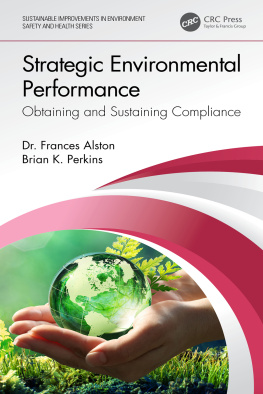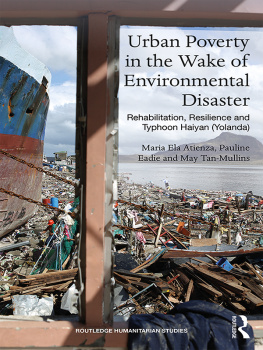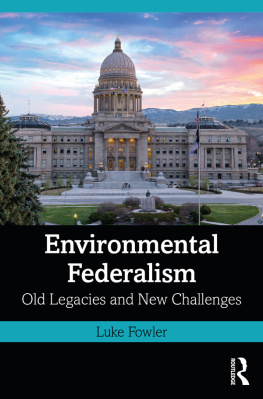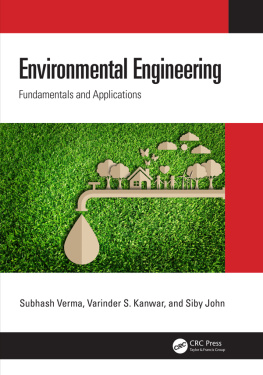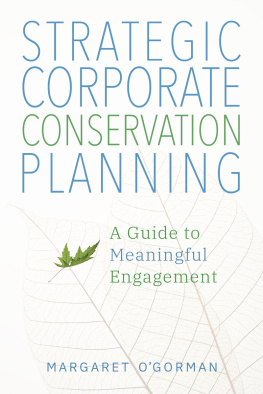Strategic Environmental Performance
Sustainable Improvements in Environment Safety and Health
Series Editor
Frances Alston
Lawrence Livermore National Laboratory, California, USA
Lean Implementation
Applications and Hidden Costs
Frances Alston
Safety Culture and High-Risk Environments
A Leadership Perspective
Cindy L. Caldwell
Industrial Hygiene
Improving Worker Health through an Operational Risk Approach
Frances Alston, Emily J. Millikin, and Willie Piispanen
The Legal Aspects of Industrial Hygiene and Safety
Kurt W. Dreger
Strategic Environmental Performance
Obtaining and Sustaining Compliance
Alston Frances and Brian Perkins
For more information about this series, please visit: https://www.crcpress.com/Sustainable-Improvements-in-Environment-Safety-and-Health/book-series/CRCSUSIMPENVSAF
Strategic Environmental Performance
Obtaining and Sustaining Compliance
Dr. Frances Alston and Brian K. Perkins

First edition published 2020
by CRC Press
6000 Broken Sound Parkway NW, Suite 300, Boca Raton, FL 33487-2742
and by CRC Press
2 Park Square, Milton Park, Abingdon, Oxon, OX14 4RN
2021 Taylor & Francis Group, LLC
CRC Press is an imprint of Taylor & Francis Group, LLC
Reasonable efforts have been made to publish reliable data and information, but the author and publisher cannot assume responsibility for the validity of all materials or the consequences of their use. The authors and publishers have attempted to trace the copyright holders of all material reproduced in this publication and apologize to copyright holders if permission to publish in this form has not been obtained. If any copyright material has not been acknowledged please write and let us know so we may rectify in any future reprint.
Except as permitted under U.S. Copyright Law, no part of this book may be reprinted, reproduced, transmitted, or utilized in any form by any electronic, mechanical, or other means, now known or hereafter invented, including photocopying, microfilming, and recording, or in any information storage or retrieval system, without written permission from the publishers.
For permission to photocopy or use material electronically from this work, access www.copyright.com or contact the Copyright Clearance Center, Inc. (CCC), 222 Rosewood Drive, Danvers, MA 01923, 978-750-8400. For works that are not available on CCC please contact mpkbookspermissions@tandf.co.uk
Trademark notice : Product or corporate names may be trademarks or registered trademarks, and are used only for identification and explanation without intent to infringe.
ISBN: 9780367471552 (hbk)
ISBN: 9781003038894 (ebk)
Typeset in Times
by Deanta Global Publishing Services, Chennai, India
Contents
Dr. Frances Alston has built a solid career leading the development and management of Environment, Safety, Health and Quality (ESH&Q) programs in diverse cultural environments. Throughout her career, she has delivered superior performance within complex, multi-stakeholder situations and has effectively dealt with challenging safety, operational, programmatic, regulatory and environmental issues.
She has been effective in facilitating integration of ESH&Q programs and policies as a core business function while leading a staff of business, scientific, engineering and technical professionals. Dr. Alston also has extensive knowledge and experience in assessing programs and cultures to determine areas for improvement and development of strategies that facilitate positive outcomes.
Dr. Alston holds a B.S. degree in industrial hygiene and safety, an M.S. degree in hazardous and waste materials management/environmental engineering, an M.S.E. in systems engineering/engineering management and a Ph.D. in industrial and systems engineering.
She is a Fellow of the American Society for Engineering Management (ASEM) and hold certifications as a Certified Hazardous Materials Manager (CHMM) and a Certified Professional Engineering Manager (CPEM). She is Adjutant Professor at Oregon State University and the 2018 President for the American Society for Engineering Manager.
Brian K. Perkins has more than 30 years of experience in environmental safety and health, quality assurance, radioactive waste management and environmental remediation. He has held various management positions in a private industry and state government and has supported U.S. Department of Energy activities at the Nevada National Security Site, the Yucca Mountain Project and Lawrence Livermore National Laboratory.
Mr. Perkins has successfully led multidisciplinary teams in the development and implementation of efficient and sustainable environmental compliance and waste management programs in various complex and highly regulated arenas. His program management and operational experience also includes environmental management systems, integrated safety management, nuclear facility safety and emergency response.
He earned his B.S. degree in geology from the University of Nevada Reno, an M.S. degree in environmental management from the University of San Francisco and has held certifications as an Environmental Manager, Environmental Auditor, NQA-1 Auditor and Hazardous Material Manager.
No matter what industry or the type of business an organization is engaged in, establishment of a corporate compliance structure is a must. A compliance structure or profile simply refers to identifying the laws and regulations that must be adhered to and the road map for ensuring compliance with applicable laws. Compliance is becoming more synonymous with conducting business no matter the industry or market in which a company competes. Regulatory compliance can range from those that apply to people management, from the viewpoint of human resource management, safety and health of workers while performing work, to protection of the environment. Recognizing that compliance for each company can be different depending on the mission of that company, the question that is important for each organization to contemplate is, what is compliance for my company? Compliance, simply put, is a companys ability to identify, conform to and follow the rules and regulations that apply to them as they conduct business. The applicable rules and regulations form the basis of a companys compliance profile. However, for some companies, it is not always easy to identify all the regulations that govern the ways in which they conduct business. In such cases, some organizations discover through regulatory inspections that they are not in compliance with a law or regulation that they have not even considered as a part of their compliance profile for the business. The compliance profile of a company is dependent upon various variables such as:
- The number of workers that a company employs
- The types of hazards that an employee can be exposed to during the performance of their tasks
- The type of potential emissions and releases to the environment
- The type of products produced
- The types of chemical products utilized while conducting business
- The type of waste or by-products produced from conducting business
- The state in which business is being conducted and the regulatory requirements specific to business conducted within that state
In addition to paying attention to the variables that can impact the structure of compliance, corporate leaders must also focus on the prevailing top compliance issues as they unfold. Keeping abreast of these issues provide an opportunity for a company to examine or assess compliance and the mechanisms used to address any of the applicable prevailing issues. These issues may include:

